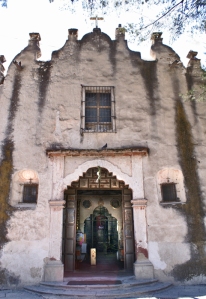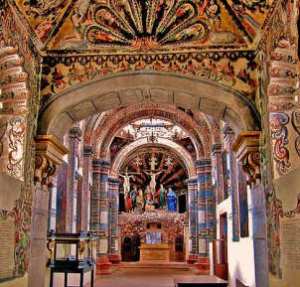 |
| The Sanctuary of Jesús Nazareno de Atotonilco, Mexico |
The Sanctuary of Jesús Nazareno de Atotonilco represents an important example of the cultural exchange between European and Latin American cultures and is a
masterpiece of Mexican Baroque. The Sanctuary, officially called the
“Santuario de Dios y de la Patria” (Sanctuary of God and Country). The complex was built in the 18th century by
Father Luis Felipe Neri de Alfaro who, according to tradition, was called upon by a
vision of Jesus with a crown of thorns on his head and carrying a cross.
The Sanctuary of Jesus Nazareno of Atotonilco is famous for its murals that reflect a syncretism of
Catholic religious iconography
mixed with native religious beliefs. The church has served as a
spiritual center for over 200 years and is still the destination of
religious pilgrimages, attracting as many as 5,000 visitors every week.
It also served as the finishing point of the famous
Mexican Independence Route.
The sanctuary comprises the church, with the Room of the Apostles
located behind its apse, and six lateral chapels. Cupolas and towers
decorate the otherwise modest facade. The sanctuary's famous pictorial
murals by Miguel Martínez de Pocasangre and the numerous artworks of the
chapels represent an iconographical program inspired by the life of
San Ignacio de Loyola.
The nave of the sanctuary is surrounded by several side chapels
arranged in a particular order for a preplanned program of worship.
The Sanctuary of Jesús Nazareno de Atotonilco is a
World Heritage Site (2008) along with the historic center of
San Miguel de Allende.
Atotonilco is located fourteen km outside the town of
San Miguel de Allende.
 |
| Interior - The Sanctuary of Jesús Nazareno de Atotonilco |
Outside
of the church complex is very simple with high walls that give it a
fortress look. The outer walls are about ten metres high; the cupolas
reach twelve metres and the clock tower is about twenty metres high.
The main church
is a single nave without a cupola, lined on the north and south flanks
by chapels and chambers. On the north side of the nave, there are the
new sacristy, the Rosary Chapel, the chambers of
Father Neri,
the Belen Chapel/Baptistery and the Reliquary Room. On the south side,
there are the Santisimo Chapel, the Soledad Chapel, the Loreto Chapel
with its back chamber, the Gloria Escondida Chamber and the Santo
Sepulcro Chapel with the Calvario Chapel behind it. The walls and
ceilings of the interior are nearly entirely covered in mural work,
sculpture, inscriptions and oil paintings in a style called
Mexican Folk Baroque, although indigenous influence can be seen. The only exception to this is the
neoclassical altars which were installed later. Most of the
mural work was done by
Antonio Martinez de Pocasangre with some done by
Jose Maria Barajas over a period of thirty years with almost no free space left among the numerous images.




No comments:
Post a Comment